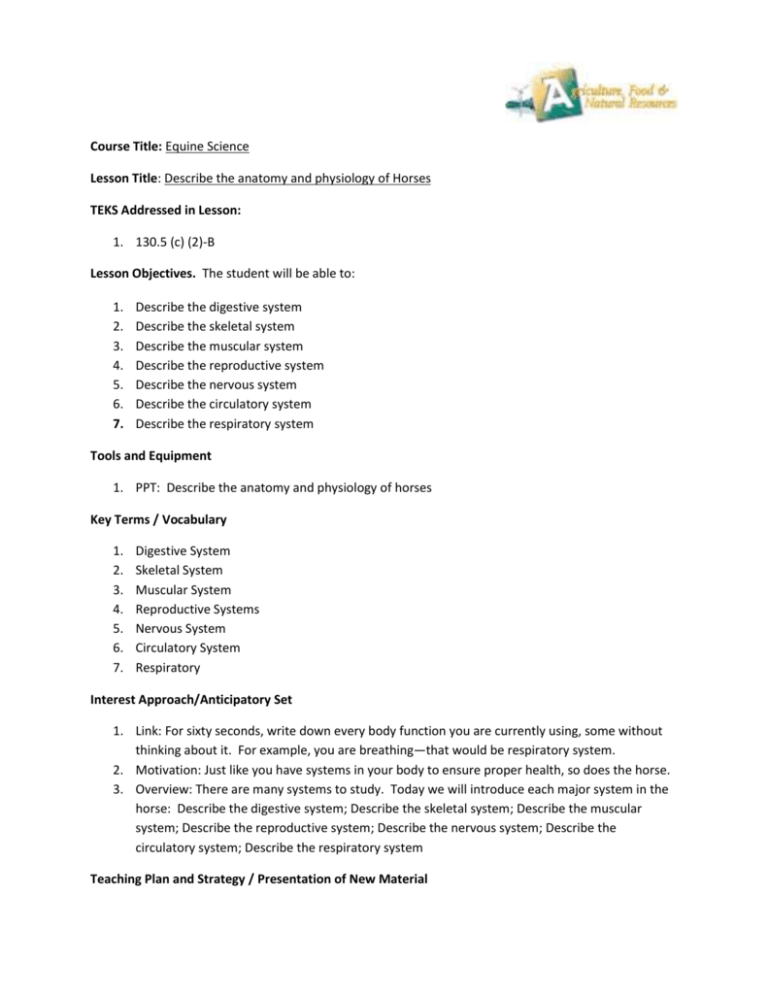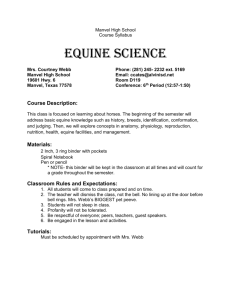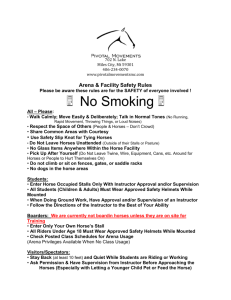Lesson 02B Anatomy and Physiology of Horses LP
advertisement

Course Title: Equine Science Lesson Title: Describe the anatomy and physiology of Horses TEKS Addressed in Lesson: 1. 130.5 (c) (2)-B Lesson Objectives. The student will be able to: 1. 2. 3. 4. 5. 6. 7. Describe the digestive system Describe the skeletal system Describe the muscular system Describe the reproductive system Describe the nervous system Describe the circulatory system Describe the respiratory system Tools and Equipment 1. PPT: Describe the anatomy and physiology of horses Key Terms / Vocabulary 1. 2. 3. 4. 5. 6. 7. Digestive System Skeletal System Muscular System Reproductive Systems Nervous System Circulatory System Respiratory Interest Approach/Anticipatory Set 1. Link: For sixty seconds, write down every body function you are currently using, some without thinking about it. For example, you are breathing—that would be respiratory system. 2. Motivation: Just like you have systems in your body to ensure proper health, so does the horse. 3. Overview: There are many systems to study. Today we will introduce each major system in the horse: Describe the digestive system; Describe the skeletal system; Describe the muscular system; Describe the reproductive system; Describe the nervous system; Describe the circulatory system; Describe the respiratory system Teaching Plan and Strategy / Presentation of New Material 1. Open the PPT titled Describe anatomy and physiology of horses 2. Progress through the slides and teach the material allowing students time for discussion on each slide 3. The digestive system: a. The digestive system is responsible for the breakdown and absorption of nutrients. b. Its parts, in order from front to back, are called the mouth, pharynx, esophagus, stomach, small intestine, cecum, large colon, small colon and rectum. c. The alimentary canal is roughly 100 feet long in an average horse, but the stomach is relatively small, holding 3-4 gallons when full. This is one reason it is better to feed horses small quantities at frequent intervals. d. 4. The skeletal system: a. Horses are members of phylum Chordata, sub-phylum Vertebrata. They have an internal skeleton which include a backbone. b. The horse's "backbone" stretches along the topline from the poll in front into the tail in the rear, and is not actually a single bone, but linked vertebrae. c. The horse's skeleton as a whole supports the horse's body, defines the basic shape or framework, protects delicate internal organs and provides attachment points for the muscles that make movement possible. d. It also houses the bone marrow, which is where blood cells form. Ligaments help connect bones. e. 5. The muscular system: a. Muscles attach to the skeleton (by way of tendons), and do the work of moving parts of the animal. b. Muscles can work only by contracting, pulling - they cannot push. Therefore, many muscles are in pairs - one to extend (or straighten) a joint, and the other to flex (or bend) that joint. c. There are three main types of muscle - skeletal muscle, which is what we usually think of when we think 'muscle', and which helps the horse walk, trot, gallop, eat, or look around; smooth, or involuntary, muscle, like the muscles of the digestive system which push the food through the alimentary canal; and heart muscle. d. The skeletal muscle fibers may be classed as two kinds: slow twitch and fast twitch. e. Draft horses and sprinters tend to have more 'fast twitch' muscle fibers, which are more powerful in the short term. f. Endurance horses and stayers tend to have more 'slow twitch' muscle fibers, which can work longer. g. In order to work efficiently, muscles must be able to relax between contractions - a muscle that is constantly contracting without frequent, short breaks to relax will become tired, stiff, and more prone to injury. h. Muscles generally get stronger with work, but overworked muscles will not be able to repair minor damage quickly enough, and may be torn, or strained. i. In the living body, different muscles are layered over each other, often two, three or four layers deep. j. Therefore, it takes more than a single picture to show many muscles. k. The next two diagrams do not show how the muscles look, but only their locations relative to the skeleton, and include many, but by no means all, of the equine muscles. l. m. 6. The reproductive system a. Horses have a typical mammalian reproductive system. b. A stallion has testicles and a penis, which is usually protected inside the sheath. c. A mare has ovaries, a uterus and vagina. d. During the breeding season (from early spring till early autumn) the mare becomes fertile at roughly three-week intervals. e. The several days when she will accept the stallion, she is said to be "in heat" or “in season” for breeding. f. g. 7. The nervous system a. The nervous system consists of the central nervous system (the brain and spinal cord), and the peripheral nervous system (the nerves in the rest of the body). b. Through the nerves to the sensory organs (ears, eyes, nose, tongue and skin), the horse perceives information about what is going on around him. c. Through the nerves to all the organs and systems of the body, the horse's brain coordinates all activities, including breathing, heartbeat, movement, and digestion. d. You might consider the nervous system to be the communications and control department for the body. e. 8. The circulatory system a. As do all mammals, horses possess a four-chambered heart which receives blood from the veins, and pumps it out into the arteries to keep the entire body supplied with oxygen and nutrients, and to move out waste products like carbon dioxide. b. Along with the heart and blood vessels, the circulatory system includes the blood, the lymph nodes and vessels, and lymph. c. The lymph system is part of the immune defenses which protect the horse from disease. d. e. 9. The respiratory system a. The respiratory system is the breathing apparatus - nostrils, larynx, trachea and lungs. b. Unlike humans, horses cannot easily breath through their mouths, but must move all air in and out through their nostrils. c. Like humans, the horse's respiratory system is vulnerable to colds, coughs, pneumonia and even "emphysema" (Chronic Obstructive Respiratory Disease - often called heaves in horses). d. Horses must often live in dusty environments, and eat dusty hay, stressing their lungs. As athletes, horses need healthy lungs to perform well. e. Activity/Application/ Student Engagement /Laboratory 1. Systems Activity: a. Pick three of the systems we discussed b. Draw and label a picture of each system and its components c. For each system describe why it is important to the horse d. Post your pictures around the classroom Evaluation / Summary 1. Questions for review: a. Which system is responsible for supporting the body? Skeletal System b. Which system is responsible for moving parts of the body? Muscular System c. Which system is responsible for breathing? Respiratory System d. Which system is responsible for oxygenating blood? Circulatory System e. Which system is responsible for absorbing nutrients from food? Digestive System 2. Summary: a. Just like in humans, the equine body is formed by many systems working together to ensure health of the animal b. Though we covered several systems, there are others we did not have time to discuss like the excretory, endocrine, immune, and integumentary system. c. In order to fully understand the anatomy and physiology of the horse, we need a basic understanding of the primary systems. d. If you want to learn more, there are many resources available online that can help you—we can even dissect a horse fetus to further study these systems. References/Additional Materials / Extended Learning Opportunities/ Enrichment 1. 2. 3. 4. The Merck Veterinary Manual: https://www.merckvetmanual.com/mvm/index.html Overview of Equine Body Systems: https://share.ehs.uen.org/node/1570 Order an equine fetus to dissect the systems discussed. Have students conduct research papers on disorders in equine related to the systems discussed; turn into a speech for prepared public speaking. 5. Watch an equine colic surgery: https://www.youtube.com/watch?v=mfysbxvqb40 (4:30 minutes) College & Career Readiness Standard: English Language Arts: V. Research, B, 1, a-b Science: VI: Biology, E. 1, F. 1-2 Social Studies: IV. Analysis, Synthesis, and Evaluation of Information. B, 2-4; V. Effective Communication. A. 1-2. Developed by the Department of Agricultural Leadership, Education & Communications, Texas A&M University for the Texas Education Agency, Educational Excellence Project for AFNR ©Texas Education Agency, 2015







